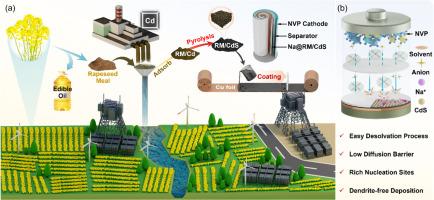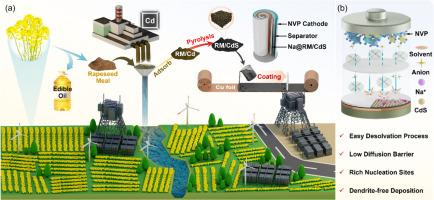从废物到财富:cd吸附菜籽粕到用于高性能钠金属电池的cd修饰纳米碳
IF 20.2
1区 材料科学
Q1 CHEMISTRY, PHYSICAL
引用次数: 0
摘要
钠金属电池(smb)由于其低成本、低氧化还原电位和高容量而被认为是最有前途的储能技术之一。然而,由于钠沉积不均匀导致的枝晶生长阻碍了其实际应用。本文提出了一种以Cd吸附的菜籽粕(RM/Cd)为前驱体合成Cd修饰纳米碳(RM/Cd)用于Na阳极修饰的绿色策略。油菜籽粕作为生物质废弃物,由于其富含S,N, o官能团,能够有效净化含Cd2+废水。通过后续热解,直接将RM/Cd转化为结构成分可控的RM/Cd。由于采用RM/CdS修饰Na阳极的集流剂,亲钠CdS纳米颗粒及其衍生物易于Na+脱溶,Na+扩散势垒低,成核位丰富,从而降低了阳极的Na成核过电位,有利于无枝晶Na沉积。因此,在非对称半电池和对称半电池中,分别实现了900次循环99.87%的高平均库仑效率和1400h以上的低过电位长寿命。改性的Na阳极进一步用于与Na3V2(PO4)3阴极组装完整的电池,即使在1C下循环1500次后也能保持91%的优异容量,显示出在中小企业中的应用前景。本文章由计算机程序翻译,如有差异,请以英文原文为准。


From waste to wealth: Cd-adsorbed rapeseed meal towards CdS-decorated nanocarbons for high-performance sodium metal batteries
Sodium metal batteries (SMBs) are considered one of the most promising energy storage technologies due to the low cost, low redox potential, and high capacity of sodium (Na) anodes. However, dendrite growth caused by uneven Na deposition hinders its practical application. Herein, a green strategy is proposed to synthesize CdS-decorated nanocarbons (RM/CdS) for Na anode modification using Cd-adsorbed rapeseed meal (RM/Cd) as precursor. As biomass waste, rapeseed meal (RM) can efficiently purify Cd2+-containing wastewater due to its S,N,O-enriched functional groups. By following pyrolysis, the RM/Cd is directly transformed into RM/CdS with controllable structural composition. As RM/CdS is used to modify the current collector for Na anode, the sodiophilic CdS nanoparticles and derivates enable easy Na+ desolvation, low Na+ diffusion barrier, and rich nucleation sites, thus reducing the Na nucleation overpotential of the anode and facilitating dendrite-free Na deposition. Consequently, a high average Coulombic efficiency of 99.87 % over 900 cycles and a long lifetime over 1400 h with low overpotential are achieved in asymmetric and symmetric half cells, respectively. The modified Na anodes are further used to assemble full cells with a Na3V2(PO4)3 cathode, which exhibited excellent capacity retention of 91 % even after 1500 cycles at 1C, demonstrating a promising application in SMBs.
求助全文
通过发布文献求助,成功后即可免费获取论文全文。
去求助
来源期刊

Energy Storage Materials
Materials Science-General Materials Science
CiteScore
33.00
自引率
5.90%
发文量
652
审稿时长
27 days
期刊介绍:
Energy Storage Materials is a global interdisciplinary journal dedicated to sharing scientific and technological advancements in materials and devices for advanced energy storage and related energy conversion, such as in metal-O2 batteries. The journal features comprehensive research articles, including full papers and short communications, as well as authoritative feature articles and reviews by leading experts in the field.
Energy Storage Materials covers a wide range of topics, including the synthesis, fabrication, structure, properties, performance, and technological applications of energy storage materials. Additionally, the journal explores strategies, policies, and developments in the field of energy storage materials and devices for sustainable energy.
Published papers are selected based on their scientific and technological significance, their ability to provide valuable new knowledge, and their relevance to the international research community.
 求助内容:
求助内容: 应助结果提醒方式:
应助结果提醒方式:


